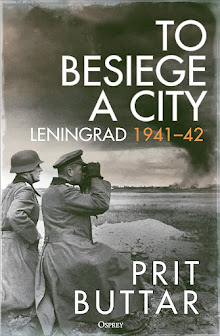Next year, on the 100th anniversary of the ill fated attack on the Chemical Works at Roeux, local dignitaries, interested parties and (hopefully) relatives of those who served in the 11th Battalion, The Suffolk Regiment, will participate in a short service of commemoration on the spot where the Cambs Suffolks fought on that day. Colin Fakes (who has a prime mover in finding a way of paying tribute to his Grandfather, Charles Stevens) and myself will be hosting a three or four day tour of places relevant to the Cambs Suffolks' first 18 months on the Western Front. As well as Roeux we will spend time at Erquinghem Lys and La Boisselle. We are particularly keen for relatives of the 82 men killed on the 28th April who have no known grave to attend as they will be commemorated on a new memorial which will be the focus of the trip. Here is a list of those men:
Askew, Harvey - 14419 - Willingham
Barber, Soloman (Sergeant) - 16606 - Coton
Barlow, William (Lance Corporal) - 24220 - Girton
Batchelor, Arthur Elton - 9687 - Diss, Norfolk
Battley, Arthur James - 43414 - Wrentham, Lowestoft
Bax, Reginald - 13114 - Chelmondiston, Suffolk
Biggs, Harry Robert - 28422 - Chittering
Bowles, George - 9132 - Back Hill, Witchford
Bradbury, Albert Russell Milles - 43424 - Lowestoft
Branch, Albert Sidney - 22480 - Chittering
Brown, Clifford Albert - 16123 - Haverhill, Suffolk
Browne, Ernest Frederick (Corporal) - 43399 - Norwich
Butcher, Allan Robert - 16123 - Ipswich, Suffolk
Catchpole, John - 24830 - Thetford, Norfolk
Charles, Frederick William - 16401 - Waterbeach
Cherry, Sidney (Serjeant) - 50457 - Luton, Bedfordshire
Circus, Thomas Edwin (Lance Corporal) - 14427 - Elsworth
Clark, William - 23996 - Bentley, Suffolk
Clarke, Henry William - 43441 - Lowestoft
Cooper, Arthur James - 22263 - Woolwich, London
Cutter, Charles Henry (Lance Corporal) - 17365 - Hinxton
Daines, William - 24160 - Oulton Broad, Lowestoft
Dennis, Walter - 28331 - St Albans, Hertfordshire
Durtnell, Richard Neville (Second Lieutenant) - Sevenoaks, Kent
Dyson, Arthur Reginald - 9765 - Thurston, Suffolk
Fiske, Alfred - 18961 - Gislingham, Suffolk
Flagg, Samuel - 16277 - March
Gedge, Arthur George - 17518 - Chesterton, Cambridge
Goldsmith, Arthur (Lance Corporal) - 13422 - Wickham Market
Goose, Percy Alfred (Lance Corporal) - 24219 - Willingham
Gould, Stanley Edmond (Lance Corporal) - 50460 - Loughton, Essex
Green, Walter - 20135 - Croydon, Cambs
Hale, John - 18718 - Bury St Edmunds
Hancock, Harry Baxter - 24422 - Oundle
Hardy, Sidney - 26293 - Long Melford, Suffolk
Harrison, George - 21004 - Stamford, Lincolnshire
Hawkins, Ernest - 43489 - Cardington, Bedfordshire
Hayes, Frank - 41158 - Harrogate, Yorkshire
Hepher, James William - 23971 - Swavesey
Hill, Owen - 18474 - Linton
Hollingworth, George William - 41159 - Leicester
Howell, Charles - 43490 - Clown, Derbyshire
Howlett, Ernest Osborne - 16235 - Wicken
Hunt, John William Reynolds (Second Lieutenant) - Coton
Jepson, William Livesey - 41132 - Darwen, Lancashire
Johnson, John Alfred - 16914 - Fordham
Kirby, Joseph - 15881 - Ely
Linford, Alfred Aaron (Serjeant) - 15663 - Swavesey
Lush, Rowland - 43498 - Bordersley, Warwick
Mannall, Robert - 20813 - Charsfield, Suffolk
Mayhew, Walter - 18434 - Redingfield, Suffolk
Mead, Charles Arthur - 24166 - East Bergholt, Suffolk
Missen, Arthur - 18367 - Lavenham, Suffolk & Trumpington
Neal, Nathaniel (Corporal) - 16248 - Littleport
Nunn, Albert George - 9597 - Stowlangtoft, Bury St Edmunds
Palmer, Charles William - 18212 - Beck Row, Suffolk
Parr, Thomas Kelly - 39788 - Fordham, Ely
Patterson, William George - 25238 - Catton, Norwich
Pettit, William Charles - 13606 - Horningsea
Phillips, Albert James - 26873 - Longstanton
Pipe, Willoughby Henry - 15105 - Spexall, Suffolk
Presland, Reginald - 16310 - Croydon, Hertfordshire
Rignall, Albert Bartingale - 14774 - Longstanton
Runnacles, Harry (Lance Corporal) - 12080 - Badingham, Suffolk
Sanders, Ernest - 50049 - Cromer, Norfolk
Smith, Harry - 235222 - Newark, Nottinghamshire
Smith, James - 21006 - Stetchworth, Newmarket
Snare, Lewis - 24876 - Fordham, Newmarket
South, Ernest - 24738 - Wilbraham
Speechley, Harold - 24420 - Glapthorne, Northamptonshire
Stevens, Charles William (Lance Serjeant) - 17203 - Swaffham Bulbeck
Steward, Samuel - 24704 - Woolpit, Suffolk
Taylor, William - 16604 - Harston, Cambridge
Thomson, Alexander William - 50686 - Shepherd's Bush, London
Topham, Percy - 24316 - Unknown
Tyndall, Thomas Image - 39449 - Wisbech
Tynet, Thomas Harold - 27669 - Paddington, London
Watson, Clement Frederick - 16419 - Cambridge
Wedd, Albert - 20115 - Melbourn, Hertfordshire
White, George - 34159 - Tottenham, London
Willingham, William George (Corporal) - 43388 - Ipswich, Suffolk
Wright, William - Quy, Cambridge - 31855
Talking about the Stevens story to Gerald Main from the BBC - click here.














































